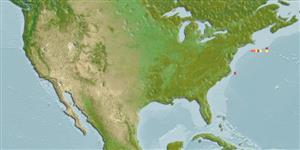Teleostei (teleosts) >
Perciformes/Cottoidei (Sculpins) >
Liparidae (Snailfishes)
Etymology: Psednos: Greek, psednos, -e, -on = rare (Ref. 45335); barnardi: Named for Keppel Harcourt Barnard who first described the genus Psednos (Ref. 42989).
More on author: Chernova.
Environment: milieu / climate zone / depth range / distribution range
Ecology
Marine; bathydemersal; depth range 750 - 1368 m (Ref. 42989). Deep-water
Northwest Atlantic: near southeast slope off New England, USA.
Size / Weight / Age
Maturity: Lm ? range ? - ? cm
Max length : 3.4 cm SL male/unsexed; (Ref. 42989)
Dorsal soft rays (total): 39 - 41; Vertebrae: 47. No coronal pore, 6 preoperculo-mandibular pores, small eye (18% HL), gill slit 1.6 eye diameter, short mouth (cleft reaching to below anterior margin of eye). Caudal part of body unpigmented, skin on chin and lower jaw black.
Life cycle and mating behavior
Maturities | Reproduction | Spawnings | Egg(s) | Fecundities | Larvae
Chernova, N., 2001. A review of the genus Psednos (Pisces, Liparidae) with description of ten new species from the north Atlantic and southwestern Indian Ocean. Bull. Mus. Comp. Zool. 155(10):477-507. (Ref. 42989)
IUCN Red List Status (Ref. 130435)
Threat to humans
Harmless
Human uses
Tools
Special reports
Download XML
Internet sources
Estimates based on models
Preferred temperature (Ref.
123201): 3.1 - 3.9, mean 3.6 °C (based on 5 cells).
Phylogenetic diversity index (Ref.
82804): PD
50 = 0.5000 [Uniqueness, from 0.5 = low to 2.0 = high].
Bayesian length-weight: a=0.01000 (0.00244 - 0.04107), b=3.04 (2.81 - 3.27), in cm total length, based on all LWR estimates for this body shape (Ref.
93245).
Trophic level (Ref.
69278): 3.2 ±0.5 se; based on size and trophs of closest relatives
Resilience (Ref.
120179): High, minimum population doubling time less than 15 months (Preliminary K or Fecundity.).
Fishing Vulnerability (Ref.
59153): Low vulnerability (10 of 100).
